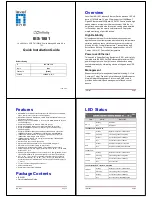
25
These two variables control a port’s ability to transmit and receive VLAN traffic.
The difference between them provides network segmentation, while still allowing
resources to be shared across more than one VLAN.
Take for example a packet that is transmitted by a machine on Port 1 that is a
member of VLAN 2 and has the Port VLAN ID number 2 (PVID=2). If the
destination lies on another port (found through a normal forwarding table lookup),
the switch then looks to see if the other port (Port 10) is a member of VLAN 2 (and
can therefore receive VLAN 2 packets).
If port 10 is not a member of VLAN 2, then the packet will be dropped by the
switch and will not reach it’s destination. If Port 10 is a member of VLAN 2, the
packet will go through. This selective forwarding feature based on VLAN criteria is
how VLANs segment networks. The key point being that Port 1 will only transmit
on VLAN 2, because it’s Port VLAN ID number is 2 (PVID=2).
VLAN Configuration
You can assign the PVID for any ports in a domain.
Содержание GN-GSV2401S
Страница 5: ...1 Chapter 1 Getting Started...
Страница 8: ...4 Chapter 2 Introduction to the Gigabyte 2 24 Ports 10 100 1000 Mbps Gigabyte Switching Hub...
Страница 14: ...10 Chapter 3 Installing and Using the Gigabyte Switching Hub...
Страница 18: ...14 Figure 3 5 System Diagnosis...
Страница 24: ...20 Figure 3 12 1000Tx 1 2...
Страница 31: ...27 Edit Delete a VLAN Group You can modify or delete the settings for an existing VLAN...
Страница 34: ...30 Edit Delete a VLAN Group You can modify or delete the settings for an existing VLAN...
Страница 40: ...36 Chapter 4 Product Specifications...















































